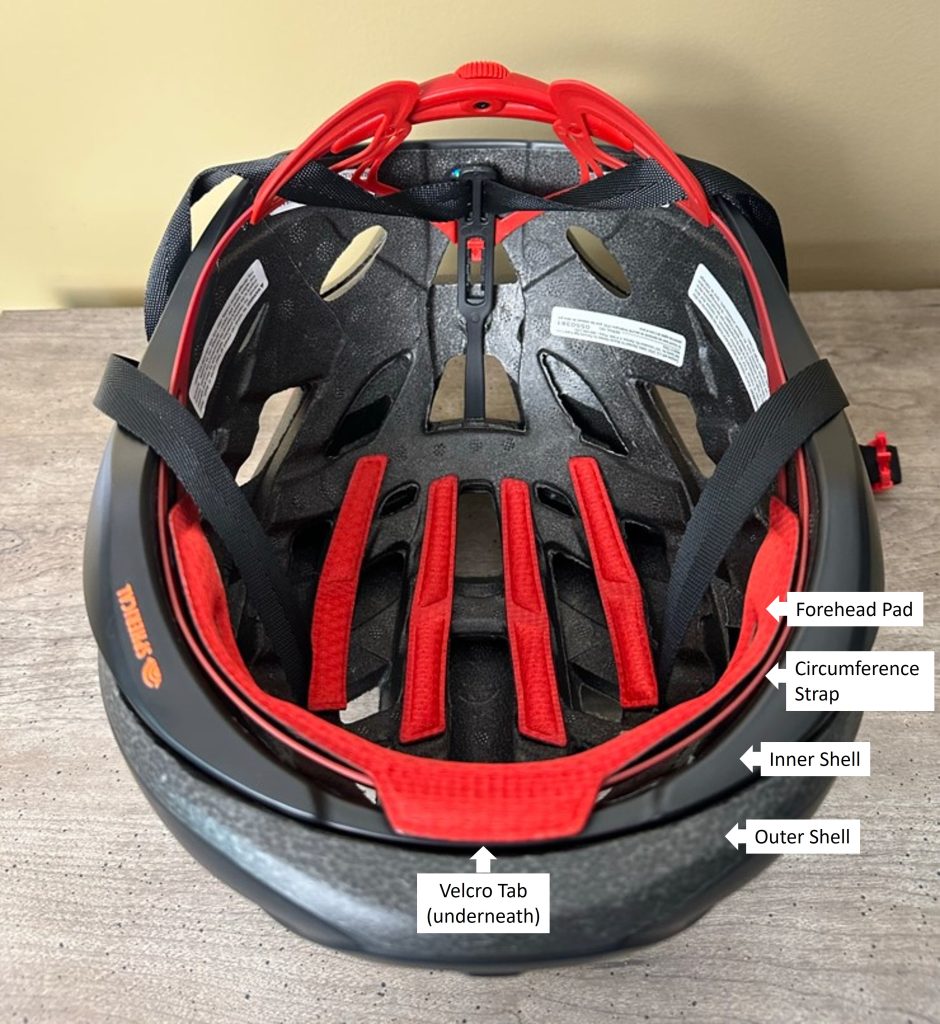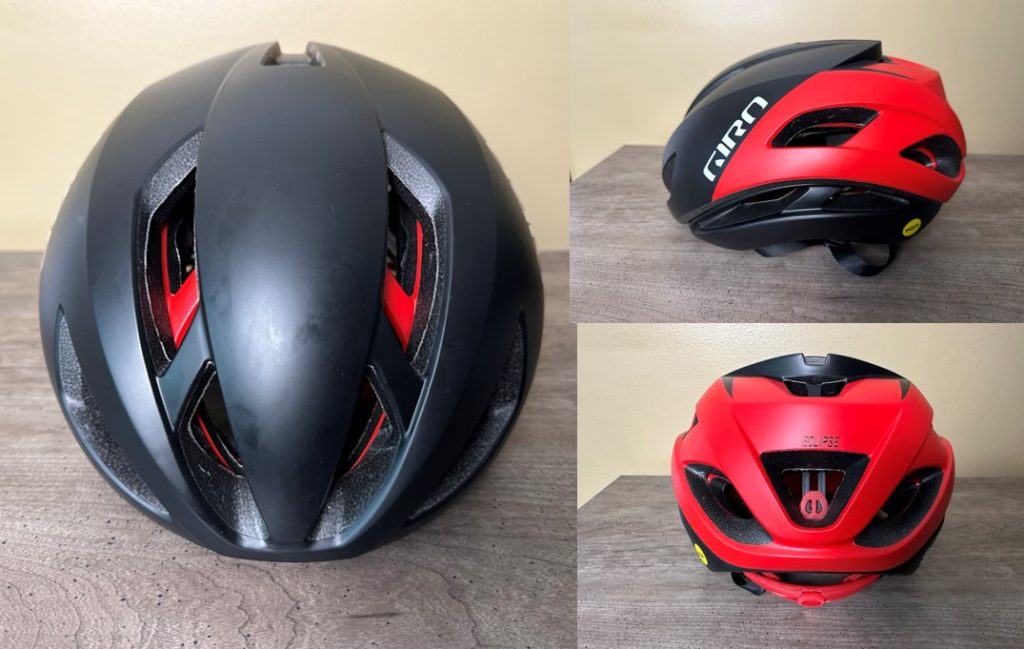GIRO ECLIPSE SPHERICAL – SOLID NOT STANDOUT

The Giro Eclipse Spherical is a very capable aero road helmet. Its safety, fit, comfort, function, and form are all quite good.
But in the continually evolving aero road helmet category, my fellow tester Adam and I didn’t find any performance or characteristics that stand out about this helmet compared to those from other brands we’ve tested.
That may be fine for those who want the solid attributes and 20% lower price the Giro Eclipse offers compared to the features and style of some of the other leading, more expensive lids.
SPHERICAL MIPS DRIVES SAFETY AND FIT CHARACTERISTICS
As with the Giro Aries Spherical, the brand’s standard road helmet, the Spherical MIPS system used is central to the safety and fit of the Giro Eclipse Spherical.
Both helmets have a shell within a shell design. Like a ball and socket joint, the upper shell can move in multiple directions, independent of the lower shell that’s closest to your head. This reduces the rotational impact on your head in case of a fall.
The Spherical design, one approved by MIPS, earns the Eclipse five stars in the Virginia Tech Helmet Ratings. Its score is roughly in the middle of the 100 or so cycling helmets of all types using traditional MIPS and other safety approaches that also achieve five stars.
The circumference strap in the Eclipse sits about 3/8” or 5mm away from the shell across your forehead and out to your temples. That makes the helmet feel somewhat independent of your head and lighter than those where the shell remains in direct contact with those areas of your head.
As Adam learned, this design aspect, which I believe is also part of the Spherical system, can lead to some helmet bobbing and sunglass contact if you ride it off-road with large-lens sunglasses. I experienced the same thing riding the Aries on gravel. I eliminated it by raising the helmet height a notch or two so the helmet stayed above my goggle-size shades.
Giro adds a Velcro tab to the large forehead pad that connects it to the brow of the helmet shell. Perhaps they did this to reduce the bobbing without reducing the somewhat detached and lighter helmet feel of the Eclipse Spherical design.
The circumference strap and pad are key to how the helmet fits. You tighten the strap to shape it to your head with a dial integrated into the cradle that sits just below the Eclipse’s lower back edge.
The rest of the fit adjustment mechanisms – straps, clips, etc. – are proven and rather straightforward. There’s a 3-position helmet height adjustment but none to change the cradle width. The rear strap laces through the cradle and comes down behind your ears. There it connects to the front straps with simple threading clips.
You can adjust the height and fore-aft position of the clips by pulling them and the straps one way or another. While the straps themselves aren’t particularly stiff compared to others, and I need to ensure the back strap is straight before I put the helmet on, I found the force of the straps against the clips keeps everything in place.
A standard locking clip below your chin connects the straps. The extra strap length beyond the clip is good for both Adam’s big neck size and my small one. A solid band keeps the excess in place. Finally, the straps lay against each other neatly below the ears.
With that tedious but hopefully clear description out of the way, the key point is that it all works to deliver a secure and safe fit.
GOOD COMFORT FOR AN AERO ROAD HELMET
You can only judge a helmet’s comfort after you dial in the fit. While you can make a helmet feel comfortable by fitting it loosely, you won’t be safe or aerodynamic if your shell or straps are flopping around.
Adam and I found the Giro Eclipse Spherical comfortable for an aero road helmet. The forehead pad and four pads that run front to back across the top of the head supply good cushioning.
As I described earlier, the Spherical system’s circumference strap makes the helmet feel somewhat independent of your head. This adds to the comfort, at least for me. Adam favors the more integrated feel of the standard MIPS system, where the pads running front to back across the top of your head are attached to a thin layer of plastic. In the event of a crash, the pads and plastic will stay with your head as the shell they sit inside moves to reduce rotational impact.
Of course, airflow is also critical to comfort. I find the Eclipse does as good a job as many aero road helmets on the warmest and most humid days. Fortunately or, perhaps, unfortunately, we’ve had many of those days lately to test out how comfortable helmets are in those conditions.
The Eclipse’s forehead pad also soaks up a lot of sweat, some of which would have dropped down into my eyes or sunglasses with other helmets.
All of the above said, note that I have added the qualifier “for an aero road helmet” several times when describing the Giro Eclipse comfort.
While most better aero road helmets weigh within 20-30 grams, or about 10% of the best ventilated cycling helmets that aren’t optimized for aero performance, the airflow in helmets optimized for ventilation is noticeably better, making them more comfortable on hot, humid days.
However, we have recently tested a couple of aero road helmets, including the Trek Ballista, that are as cool as the best ventilated, non-aero optimized road helmets.
FINE FORM AND FUNCTION
While not displaying the most aero lines or polarizing style of several of its aero road helmet competitors, the Giro Eclipse Spherical is a sleek helmet with a blunted back end that clearly distinguishes it from standard cycling helmets.
I have no way to assess the aero drag of the Eclipse scientifically and don’t buy into the figures helmet makers provide. Anecdotally, the air I feel and the noise I hear rushing over my ears while wearing the Giro Eclipse Spherical is more than what I’ve experienced with standard road helmets, including the most ventilated ones, and is in the same range as with other aero road helmets we’ve tested.
Within that range, the Eclipse is a little quieter than other aero road helmets. I don’t know what, if anything, that says about its aero performance.
Sunglasses don’t conflict with the circumference or down straps in the Eclipse or with the helmet’s outer shell brow if you have the height adjustment set to avoid it. Placing your shades upside down, they also dock securely in the outermost front vents.
I’ll admit to buying the black and red model for testing to match my bike’s frame colors. The Eclipse also comes in white-silver and matte black-glossy black combinations, blue, and charcoal with pink and sky blue sprinkles. The matte finish on the black and red we tested mutes the colors and look of the helmet somewhat. That’s consistent with it not standing out for its features or aero look.
If that performance and styling speak to the stealth side of your cycling nature, the Giro Eclipse Spherical is a good, well-priced option. With an MSRP/RRP of US$250/£240/€310, you can order it online at Competitive Cyclist, BTD (BikeTiresDirect), Performance Bicycle, Sigma Sports, Amazon, and BikeInn, all stores I’ve vetted and recommended for their competitive prices, high independently verified customer satisfaction ratings and good, enthusiast-level product selection.
In The Know Cycling is ad-free, subscription-free, and reader-supported. If you want to help keep it rolling without any added cost to you, buy your gear and kit after clicking the store links on the site. When you do, we may earn an affiliate commission that will help me cover the expenses to create and publish our independent, comprehensive, and comparative reviews. Thank you, Steve. Learn more.
You can compare this helmet to competitively performing models in my review of the Best Aero Helmet for Road Cyclists.


I bought this helmet a few months ago (also to match my bike’s colors, guilty), looking for an “aero” helmet that also looked to have good ventilation since I don’t particularly trust anything where I can’t squirt water onto the top of my head on a 90+ degree day.
My Oakley Half Jacket sunglasses don’t fit great into the vents in either orientation but it’s much better than some other aero and standard helmets for sure, and the arms of the sunglasses get snagged up in the back of the cradle more often than I’d like, but maybe I need to play around with the height adjustment.
Otherwise, I wish it had more red and less black, especially on the front for better visibility, but I got hit by a car recently, with my head hitting the pavement and I walked away with my brain still intact, so unplanned real-world testing supports the Virginia Tech tests…
Whoa! I guess the Eclipse’s performance in your “real-world” safety testing makes whatever deficiencies in the sunglass docking and colors less important the the overall scheme of things. Good to hear you survived it all.
Just seeing your reply now, whoops.
I’ve subsequently taken the helmet to Sicily in mid September which had a very wide variety of conditions (chilly rain to hot sun). Helmet remained comfortable, though I can confirm the aero gains, insofar as they exist, were not enough to overcome 20+ mph constant headwinds for near 2 hours, sigh….might need one of those Specialized Darth Vader TT helmets like Remco uses
I own this helmet in blue. Biggest issue I have is sweat retention in the front cushion pad. Once it gets supersaturated, it becomes a dripping sponge of sweat into your sunglasses. Only way I can find to drain some of it is to push the helmet against my forehead to squeeze some sweat out while riding. Really not ideal, but it may be the only way for me to deal with this very uncomfortable problem. Don’t know if a more well ventilated helmet like a POC or equivalent would help in sweat evaporation. Open to any suggestions.